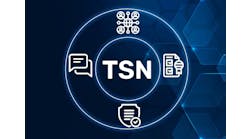Why time-sensitive networking will change everything
The Industrial Internet of Things (IIoT) is a part of most industrial automation applications. The industry is marching toward the next phase of automation, inching closer to Industry 4.0 with better data connection and trafficking and the convergence of information technology (IT) and operational technology (OT).
Time-sensitive networking (TSN) is an important part of what’s needed for the next steps in automation development, with the high-speed precision and infrastructure interoperability that’s needed for truly autonomous operations and deterministic control.
While it’s not ready for prime-time industry-wide use, TSN is getting closer with the latest Institute of Electrical and Electronics Engineers (IEEE) standards.
The TSN task group is part of the IEEE 802.1 working group, tasked with developing standards and recommended practices for network management, security and protocol layers. The TSN working group evolved from the former IEEE 802.1 Audio Video Bridging (AVB) task group. The group has released a number of new standards in 2020, and the industry awaits one more standard, expected in a few years, that will help make TSN ubiquitous in industrial automation applications.
TSN toolbox
“TSN is not just one thing. It can best be thought of as a toolbox of different IEEE standards that can be applied as needed,” says Michael Bowne, executive director of PI North America. “Not every industry will need all the standards. Those applicable to factory automation may not be applicable to aerospace.”
PI North America was founded as the Profibus trade organization, dedicated to promoting the use of fieldbuses in general and particularly Profibus and Profinet.
“It is critical that every key player in the value chain, including machine builders and end-user engineers, make the investment now in cross-market collaborative standards development, testing and certification activities, like the work that we are doing within Avnu Alliance to fully capitalize on the increasing demands for wireless, time-sensitive applications,” says Dave Cavalcanti, wireless TSN workgroup chair at Avnu Alliance and principal engineer at Intel. Avnu Alliance is a consortium of automotive, electronics and industrial manufacturing companies working together to establish TSN standards.
Some manufacturers have introduced TSN-ready products, and applications are testing them quietly, but widespread use is still awaiting important standards to ease the configuration process and ensure interoperability. Many organizations and manufacturers continue to work together on projects for testing and standards development.
“It is important to understand that TSN is not a single specification. It won’t roll out all at once; TSN capabilities will increase over time,” says Tom Weingartner, industrial segment chair at Avnu Alliance and business development director of Industrial Ethernet Technology Group at Analog Devices.
“Users may choose to add TSN capability to infrastructure or a subset of devices before extending it to an existing application. That way, as applications mature, the TSN capability to support them is already there. The question is always, ‘When is the right time?’ That will depend on the machine builder and end user: understanding the advantages of TSN, when does beginning this implementation process fit the overall needs?” says Weingartner.
Configuring the network: profiles for industrial automation
A number of TSN standards have been developed over the past three years. In 2018, IEEE 802.1Q-2018 (Standard for Local and Metropolitan Area Networks—Bridges and Bridged networks) specified how the media access control (MAC) service is supported by bridged networks, the principles of operation of those networks, and the operation of MAC bridges and VLAN bridges, including management, protocols and algorithms.
“Since 2018, the most important developments around TSN have been on configuring the network. This work is being performed in conjunction with the IEC and is known as the IEC/IEEE 60802 TSN Profile for Industrial Automation,” PI’s Bowne says. “60802 harmonizes how a TSN network is set up by the user. It would be a terrible failure if proprietary flavors of TSN emerged, and the TSN from one automation vendor was incompatible with the TSN from another. To that end, 60802 attempts to ensure this will not be the case.”
In the news: Ethernet-APL technology standards mean products entering the market
The International Electrotechnical Commission (IEC) is an international standards organization for all electrical, electronic and related technologies.
“60802 TSN will encourage further connection of what were previously separate networks and lead to even greater cooperation between those with IT and OT networking backgrounds,” Dr. Al Beydoun, president and executive director at ODVA.
This would allow, for example, automated guided vehicles (AGVs) and welding robots to leverage the same well-engineered Wi-Fi network with 60802 TSN, Beydoun says. “The use of singular converged networks will also make it easier to accelerate digitalization activities for the plant floor, such as using cloud analytics to determine when to replace equipment,” he says.
ODVA is a standards development association for industrial automation companies, working to advance open, interoperable information and communication technologies.
The 60802 project started in 2018 and is making slow but significant progress. “This is a prerequisite for implementing convergent networks that permit network sharing between different IT and OT protocols. A first, official version is expected by the end of 2022,” says Peter Lutz, director field level communications at OPC Foundation, a global industry organization for users and vendors to collaborate in creating data transfer standards for multi-vendor, multi-platform, secure and reliable interoperability in industrial automation.
More steps for better data
While 60802 has been marching toward consensus, other core features have been added to the base 802.1 standards in 2020, such as asynchronous traffic shaping (802.1cx-2020) and YANG data models (802.1Qcr-2020).
“TSN profiles for automotive and 5G networks are continuing, while new profiles for aerospace and audio/video are getting kicked off,” ODVA’s Beydoun says.
In 2020, IEEE released of the time synchronization standard (802.1AS-2020). “This standard has added important timing and synchronization capabilities to the TSN standards, defining the transport of time messages over Ethernet (IEEE 802.3) and wireless networks in order to achieve precise time synchronization across a TSN network,” OPC’s Lutz says.
Also read: The accumulating case for deterministic control
He adds, “An efficient use of TSN mechanisms, to ensure deterministic communication, requires a suitable configuration, especially when attempting to keep complexity low. The IEEE 802.1Qcc standard is of fundamental importance for this, but, in many places, it provides more of a framework than a concrete implementation. Therefore, other complementary standards are necessary to enable 802.1Qcc to be used in a meaningful way. For the centralized configuration approach, these standards include the communication between the centralized network configuration and centralized user configuration, which will be specified in IEEE 802.1Qdj. Alternatively, when considering the decentralized configuration approach, resource allocation protocol (RAP) will be specified in IEEE 802.1Qdd, using link-local registration protocol (LRP).”
Ethernet TSN is only covering layers 1 and 2 of the ISO/OSI reference model, says Lutz. “To drive convergence and harmonization on higher communication and application layers, including information models supporting semantic interoperability—layers 3-7 and above—the OPC Foundation launched the Field Level Communication (FLC) initiative back in 2018,” he says. The initiative is supported by automation suppliers throughout the world, Lutz says, in order to extend the OPC UA framework with additional features and capabilities for application and use cases in factory and process automation.
“These extensions have been named OPC UA FX (Field eXchange), and they include features and capabilities for deterministic data exchange between controllers and between controllers and field devices, including functional safety and motion control. With these extensions, OPC UA fully scales from field to cloud and back, supporting common information models and semantic interoperability between automation devices and myriad software applications at the edge or in the cloud,” Lutz says.
With complete interoperability, TSN will further enhance autonomous operations and remote monitoring. Ultimately, operations want better access to data, in order to make better decisions, autonomously or with human intervention, Jordon Woods, strategic technologist at Analog Devices’ Industrial Ethernet Technology Group, says.
“This ubiquitous access to data is one of the key values brought by TSN. By creating a uniform time synchronization and uniform handling of key traffic, TSN allows equipment to speak with a common language at Layer 2,” Woods says. “Yes, TSN is only part of a larger ecosystem that we are currently building to make the fourth industrial revolution a reality, but it is a very foundational building block.”
Early adopters: from bridges to native communication
The first industry to see immediate advantages will be automotive, predicts Thomas Burke, global strategic advisor at CC-Link Partner Association (CLPA). “In effect, this was one of the early adopters of the precursor of TSN, known as the audio/video bridging (AVB) set of standards,” he says.
TSN has potential for widespread adoption for those that have high-speed deterministic networks and those that need reliable communication for data-driven activities. “Currently, the AVB specifications are successfully used in various automotive ‘infotainment’ systems. TSN, with its expanded scope, is proving extremely useful to support autonomous driving applications,” Burke says.
TSN will be very valuable to companies using multiple machine tools and material handling equipment, such as furniture builders or product distribution centers, Burke adds. “The factory floors are packed with a multitude of disparate devices that communicate across a multitude of networks to support increasingly automated applications, including the use of autonomous mobile robots (AMRs) or feedback loop control,” he says.
TSN simplifies network infrastructure, with overall less cabling and fewer devices needed, while supporting the convergence of different types of data traffic. “By building determinism into standard Ethernet, TSN provides the foundation for safety in key applications,” Burke says. Most autonomous operations or remote monitoring requires this kind of highly reliable communication and support for high data traffic. Businesses with those demands also need a system that can tie together information technology and operational technology. “It builds determinism into standard Ethernet, ensuring reliability in the transfer of time-critical OT data, and facilitating the analysis of OT data, as well as its conversion into information for IT applications. As a result, it can support increasingly motivated applications, providing the power necessary to effectively support multiple highly automated systems,” says Burke.
TSN will also drive power-over-Ethernet (PoE) systems based on single-pair Ethernet (SPE), Burke says. A single twisted pair of copper wires can be used in place of four, reducing the initial investment, operating expenses and cabling footprint.
Industries such as food and beverage, pharmaceutical and aerospace could all benefit from TSN. Beydoun at ODVA agrees that automotive is poised to lead the way in terms of adopting 60802-compliant TSN automation devices, and he sees many other applications next in line. “One of the advantages of 60802 TSN will be to allow cameras to operate on the same network segments as deterministic-control devices like welding robots. This will enable machine learning via cameras to be efficiently and more easily implemented to root out quality defects across the plant,” Beydoun says.
Those industries with capital-intensive manufacturing facilities and/or high levels of regulatory requirements will likely invest in TSN early on, Beydoun predicts.
Thomas Berndorfer, executive board member at TTTech Industrial, says TSN, as an extension to Ethernet, will become the standard networking technology for any industrial-automation application where deterministic communication is a requirement.
“TSN is also being developed for use in transportation use cases, such as in-car networking and train communication networks,” Berndorfer says. “The capabilities that TSN adds to Ethernet networking bring the most value to industrial applications where control systems are getting interconnected at the edge, while networking bandwidth is limited.” He says an example of a sector that is pioneering the use of TSN is the plastics industry. “The industry standard EUROMAP 79 specifies using TSN as the networking technology for injection molding machines to ensure interoperability between various machine elements,” Berndorfer says.
He also recommends that organizations with autonomous operation or remote monitoring should be looking to implement TSN in the coming years. “The primary benefit that TSN brings for these industrial automation scenarios is that it provides guarantees for critical communication while also allowing other applications to use the network,” Berndorfer says. “This means that controllers of machines such as multi-axis robots can send synchronization messages over TSN even when the same network link is being used for bandwidth intensive traffic, such as streaming video. Data for remote monitoring can also be accessed via TSN without fear of disturbing low-latency applications. This network convergence will lead to significant reductions in hardware and wiring costs, as well as lower maintenance efforts.”
Burke says for machine-to-machine communications, a key development was the launch of CC-Link IE TSN in 2018, an industrial Ethernet network technology based on TSN. “One of the most important trends that we have been witnessing in the past two years is the move away from network bridges and gateways. Instead, specialists are offering key solutions to support native communications between different devices that used to operate on disparate networks and protocols,” Burke says. “Finally, one of the latest developments for TSN-driven applications is the automation of network configuration tasks. This capability can streamline modifications of the overall infrastructure for expansions, repurposing and temporary adjustments.”
With this native communication between machines, manufacturing applications leveraging sensors and automated robots stand to benefit from TSN, Weingartner of Avnu Alliance says. “A time-sensitive network allows the remote control, programming, diagnostics, rerouting, and interaction of automated components. Connected devices can react to input dynamically and in synchronization, creating an AI-ready network of devices that can be flexibly redeployed as needed.
TSN ensures that this complex orchestration occurs within acceptable latency and reliability parameters, using standard network components,” he says.
In addition to simplifying device connections during operations, all the devices in a TSN share information to automate traffic planning and data delivery. “This data sharing makes it possible for the control plane to be configured automatically rather than manually. In the near term, we should start to see network management engines capable of configuring all the network bridges to optimize traffic flows for deterministic networks,” Weingartner says.
It should also be possible for TSN to operate across multiple available physical layer technologies, including wired and wireless, says Cavalcanti of Avnu Alliance/Intel. He says enabling wireless TSN capabilities that are interoperable with wired TSN, given the stochastic nature of wireless communications, is challenging. “The Avnu Wireless TSN working group is engaged in evaluating the TSN-relevant capabilities in these next-generation wireless networks, as well as defining other steps that must be undertaken for the successful rollout of wireless TSN interfaces to wired TSN,” Cavalcanti says.
Industry solutions to TSN challenges
While much progress has been made on TSN and industry-wide application seems within reach, other challenges remain. The working groups, testbeds and pilot projects continue to work out the kinks, finding solutions to the industry’s TSN challenges.
The initial high cost of the technology could be a barrier for some. “It is important to reassure machine builders and end users that the cost of chips will decrease, as the technology becomes more popular. Therefore, the availability and accessibility of TSN-driven solutions will only increase, supporting even businesses with limited capitals available to upgrade their systems,” CLPA’s Burke says.
“It is unfinished and there are quite a few overlapping standards, which will lead to incompatibilities. There is no current ability to verify conformance and interoperability. Yes, there are TSN networks out there, but they are basically closed systems,” says Bob Trask, North American representative for the EtherCAT Technology Group (ETG). “The danger in the short term is to get locked into a single-vendor TSN scheme, which is the very thing the industry wishes to avoid. Lack of openness drives prices higher. Additionally, TSN bridges are and will be much more expensive than standard switches.” ETG brings EtherCAT device manufacturers, technology providers and users together to further the technology.
“TSN covers only the lower layers of a communication solution, and TSN by itself does not guarantee cross-vendor interoperability,” says Dr. Thomas Brandl, product owner—PLC at Bosch Rexroth. Scalability in the near term and compatibility for the future are concerns that need a solution. “It is important to have a scalable solution using as much TSN as required and having today a control system which may be updated to the future standard easily,” Brandl says.
“Challenges for the growth of TSN include concerns for strong network security and the complexities in deploying TSN with existing technologies,” says Daniel Weiss, senior product manager at Newark. He says many market factors are also driving TSN growth, including the growth in industrial automation overall, the demand for deterministic Ethernet, the development of different industrial Ethernet protocols and the increasing adoption of IIoT and Industry 4.0 solutions.
“It’s important to understand that TSN will not replace existing industrial Ethernet and automation protocols. The emerging TSN solution is based on a toolset of multiple OSI Layer 2 standards that describe how existing real-time Ethernet protocols can be extended to meet required behaviors. They cover only the data transport layer, but they can meet a wide variety of use cases,” says Phil Marshall, CEO of Hilscher North America. He says Gigabit Ethernet will also improve implementation. “With Gigabit Ethernet, far more data will be available than is possible today, and, with higher speed and more reserved bandwidth, it will allow the transmission of more real-time data over the same wire.”
The adoption of 5G will also help machine communication for remote management, says Andrew Barco, director of automation products and solutions at Weidmuller. “TSN can play an important role in enabling precise collaboration among automation components and provide interoperable and scalable solutions to the factories,” Barco says. “From the physical layer, there are still two types of connectors on the market, and switch manufacturers have to start choosing which connector is used and design the advanced physical layer (APL) to go along with it.”
Although there are many different TSN profiles under development, one key point machine builders and end-user engineers need to take away is that there is only one TSN, says Razvan Petre, solutions architect at Spirent Communications. “A TSN profile does not introduce new standards or features,” explains Petre. “A TSN profile just narrows the focus, hence easing interoperability and deployment by describing how to build a network for a particular use. Everyone benefits by having only one common TSN and not creating technology islands.”
TSN configuration will also rely on YANG data models, Petre says. “There are specific YANG models currently under development for the core TSN protocols. The central configuration model will be the dominant one, with the roles of the CNC and CUC still being defined,” says Petre.
Michael Zapke, industrial lead at Xilinx, agrees that openness is important. “The key word is ‘transparency,’ the accessibility of data from each element within a machine at any time with the right timestamp and in a high sample rate. This comes in combination with the need to establish a lifecycle management that includes the capability to enforce software updates,” Zapke says. “The harmonization of TSN profiles for switches and for endpoints and related conformance classes have high importance right now. Also, extensions for security to protect synchronization will help to improve the adoption of TSN.”
A management model which supports the scalability of these converged networks is required, says Analog Devices’ Woods. “Driving Ethernet-based technologies to the edge of the network introduces new security vulnerabilities. Finally, the whole idea of coexistence and interoperability assumes the existence of a common conformance assurance methodology so that TSN is TSN throughout the network,” says Woods. “It is easy to become overwhelmed in light of these seemingly daunting challenges. One can be forgiven for concluding that practical deployment of time-sensitive networks is years away. However, those reaching such a conclusion ignore a simple fact: Industrial Assessment Center manufacturers have been deploying deterministic Ethernet technologies for over a decade. While the full vision of the factory of the future may take some time to materialize, IAC manufacturers will lean on the experience of the past to achieve deployment of TSN-based networks sooner rather than later. Existing design, deployment and management techniques will be adapted to the TSN paradigm.”






